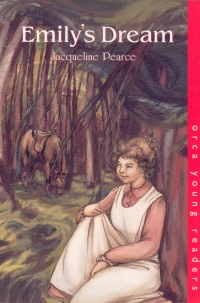| ________________
CM . . .
. Volume XI Number 21 . . . .June 24, 2005
excerpt:
In this charming sequel to Discovering Emily, the reader follows a fictitious 15-year-old Emily Carr struggling to break free from her stern and bossy older sister, Dede, and a late nineteenth-century society where a woman is expected to be prim, proper and polite. From the first paragraph on, the author reveals to us an impish and defiant Emily as she hides in a hay loft, eluding her sister and avoiding punishment. Dede, eldest of the Carr sisters, has been raising her siblings since the death of their parents and feels it her moral duty to make certain Emily conducts herself in a civilized and proper manner. Emily has other ideas. For one thing, she is impulsive, and she does not care what others may think of her. As well, Emily is determined to become an artist, a choice of which she is certain Dede will not approve. The story gains momentum when Mr. and Mrs. Piddington arrive from London en route to San Francisco as house guests. From the moment they meet, Emily sees right through the Piddingtons' pleasant and polite façade. To her, they are snobby, disrespectful and undeserving of Dede's efforts to gain their acceptance. For example, in order to please the Piddington's, Dede purchases an old horse and carriage. Although Emily despises the Piddington's, she is thrilled to have a new friend in the old horse, Johnny, as well as a means to whisk her away from "the stifling rules and phony politeness" into the British Columbian wilderness where she feels "welcomed" and "embraced." A subtle battle soon erupts between Emily and Mr. Piddington, one which results in several humorous incidents including Emily's hiding Mr. Piddington's cigarette case, Mr. Piddington's letting Emily's canary loose and Mr. Piddington's causing Emily to become nauseous in a rowboat. It is this last event which forces Emily to lash out publicly at Mr. Piddington. When faced with yet another thrashing from Dede, Emily finally discovers the inner courage to stave off the assault and assert her desire to leave Victoria and study art in California. Ironically, when Dede at last agrees to her wishes, it is with the condition that Emily live in San Francisco with the Piddington's! Though the plot is simple and the action minimal, Jacqueline Pearce has created strong and identifiable characters, credible dialogue and vivid descriptions which drive this story forward. It is not only an amusing read, it is a clever insight into the spirit of one of Canada's best known artists. Throughout the text Pearce has stippled glimpses of the rich landscape that inspired the real artist—the skies, the waters, the muddy roads, the totems and especially the trees.
Pearce has included references to the era including, manner of dress, vocabulary and dialogue all of which appear to ring true to the century. Though the protagonist is 15, the short chapters, simple plot and large text suggest a much younger audience. The slow pace, however, may not hold the attention of children eight and younger; therefore, this reviewer recommends this novel to children ages 9 to 11. Recommended. Marina Cohen has been teaching for 10 years in the York Region District School Board of Ontario. She has a Master's degree in French Literature.
To comment
on this title or this review, send mail to cm@umanitoba.ca.
Copyright © the Manitoba Library Association. Reproduction for personal
use is permitted only if this copyright notice is maintained. Any
other reproduction is prohibited without permission.
NEXT REVIEW |
TABLE OF CONTENTS FOR THIS ISSUE
- June 24, 2005.
AUTHORS |
TITLES |
MEDIA REVIEWS |
PROFILES |
BACK ISSUES |
SEARCH |
CMARCHIVE |
HOME |
